Themed collection Analytical Methods Committee Technical Briefs

Avoiding some common mistakes in straight line regression. Part 1
This article summarises the principles and assumptions underlying linear regression plots as used in method validation and in calibration experiments, and warns of problems that may arise when the assumptions are not valid.

Anal. Methods, 2023,15, 6105-6107
https://doi.org/10.1039/D3AY90134C
Comparing measurement uncertainty values
Quoted values of measurement uncertainty (MU) are only ever estimates, being subject to their own uncertainties. This has implications for selecting a way to compare two values of MU.

Anal. Methods, 2022,14, 4025-4028
https://doi.org/10.1039/D2AY90114E
A periodic table for liquid chromatography separation modes
This technical brief describes a tool in the form of a “periodic table” to assist in optimizing liquid chromatography separations selected by following the guidance provided in AMCTB No. 107.

Anal. Methods, 2022,14, 3033-3037
https://doi.org/10.1039/D2AY90085H
Summarising the precision statistics from collaborative trials
A collaborative trial (an interlaboratory study) is reputed to be the most reliable way of validating an analytical procedure applied to a defined class of test material, however, the popularity of trials is declining while the need for information from them is escalating.

Anal. Methods, 2022,14, 678-680
https://doi.org/10.1039/D2AY90010F
X-ray micro-computed tomography for heritage building materials
X-ray micro-computed tomography can provide information about the composition and internal structure of materials commonly found in heritage buildings such as natural stone, mortar, brick, concrete and wood.

Anal. Methods, 2021,13, 5875-5878
https://doi.org/10.1039/D1AY90154K
Hand-held X-ray fluorescence analysis of archaeological artefacts: challenges, advantages and limitations
This Technical Brief discusses the main advantages and limitations of hand-held X-ray fluorescence spectroscopy applied to archaeological artefacts, together with its potential to answer research questions for archaeologists and conservators.

Anal. Methods, 2021,13, 3731-3734
https://doi.org/10.1039/D1AY90094C
Method selection for liquid chromatography
This technical brief provides an overview of the decision making process for selecting LC techniques to separate known analyte(s) from a complex liquid matrix.

Anal. Methods, 2021,13, 3205-3208
https://doi.org/10.1039/D1AY90086B
Fourier transform infrared spectroscopic analysis of organic archaeological materials: background paper
Fourier Transform Infrared (FTIR) spectroscopy is ideally suited to the cultural heritage sector due to the ability to apply it minimally or non-destructively with limited sample preparation, fast analysis times, relatively low cost, and relative ease of use.

Anal. Methods, 2021,13, 2997-3000
https://doi.org/10.1039/D1AY90064A
How reliable is my uncertainty estimate?
This document aims to explain the existence of a confidence interval (CI) on every MU estimate, and how it can be evaluated, using a worked example that includes primary sampling within the measurement process.

Anal. Methods, 2021,13, 2728-2731
https://doi.org/10.1039/D1AY90060A
Thermal desorption part 2: applications in analytical measurement
This Technical Brief aims to illustrate the uses and applications of thermal desorption methods in analytical measurement.

Anal. Methods, 2021,13, 2345-2348
https://doi.org/10.1039/D1AY90049H
Wax and wax-like materials – the what, where, and how in heritage collections
Often wax-containing objects suffer degradation: analytical chemistry provides the key to designing appropriate conservation strategies and materials for such objects in heritage collections.

Anal. Methods, 2021,13, 2075-2078
https://doi.org/10.1039/D1AY90035H
Simplex optimisation in practice
While the underlying principles of simplex optimisation are easy to understand and the small number of trial experiments involved make the approach very attractive, there are several important issues to be considered in the practical application of the method.

Anal. Methods, 2021,13, 955-957
https://doi.org/10.1039/D1AY90004H
Analysis of historical dyes in heritage objects
This Technical Brief outlines the principal analytical methods used in dye and mordant analysis, by explaining how to select the most appropriate experimental conditions and describing the types of instrumentation available.

Anal. Methods, 2021,13, 558-562
https://doi.org/10.1039/D0AY90167A
Multivariate statistics in the analytical laboratory (1): an introduction
Here we provide an introduction to multivariate statistics.

Anal. Methods, 2021,13, 274-277
https://doi.org/10.1039/D0AY90154G
Units and quantities for analytical chemistry (background paper)
This Technical Brief outlines the SI units and quantities available for use in analytical chemistry and explains the care that must be taken if alternative approaches are followed.

Anal. Methods, 2020,12, 5010-5012
https://doi.org/10.1039/D0AY90126A
X-ray micro computed tomography in cultural heritage
This Technical Brief introduces the use of X-ray micro computed tomography in cultural heritage.

Anal. Methods, 2020,12, 4496-4500
https://doi.org/10.1039/D0AY90112A
Thermal desorption part 1: introduction and instrumentation
This Technical Brief informs both analysts and less technically aware users of the capabilities and limitations of thermal desorption equipment and measurement methods.

Anal. Methods, 2020,12, 3425-3428
https://doi.org/10.1039/D0AY90082F
Experimental design and optimisation (5): an introduction to optimisation
This Technical Brief outlines the basic principles of optimisation, and introduces some of the most commonly used approaches.

Anal. Methods, 2020,12, 2422-2424
https://doi.org/10.1039/D0AY90037K
What’s novel in the new Eurachem guide on uncertainty from sampling?
This Technical Brief aims to explain how the new second edition of the Eurachem guide, Measurement uncertainty arising from sampling, differs significantly from the first edition that was published in 2007.

Anal. Methods, 2020,12, 2295-2297
https://doi.org/10.1039/D0AY90051F
An introduction to hand-held infra-red and Raman instrumentation
This Technical Brief aims to inform both analysts and less-technically aware users of the applications, capabilities and limitations associated with the use of hand-held infra-red and Raman instrumentation.

Anal. Methods, 2020,12, 1532-1535
https://doi.org/10.1039/D0AY90025G
To p or not to p: the use of p-values in analytical science
This article explains what a p-value is and the pros and cons of using them. Concluding that they are a useful method of interpreting data.

Anal. Methods, 2020,12, 872-874
https://doi.org/10.1039/C9AY90196E
The edge of reason: reporting and inference near the detection limit
This Technical Brief describes the principal internationally recognised approach to decision and detection limits.

Anal. Methods, 2020,12, 401-403
https://doi.org/10.1039/C9AY90188D
Laser-induced breakdown spectroscopy (LIBS) in cultural heritage
This Technical Brief describes the basic concepts of laser-induced breakdown spectroscopy, presents relevant aspects of instrumentation and discusses how the technique is applied in the context of cultural heritage studies.

Anal. Methods, 2019,11, 5833-5836
https://doi.org/10.1039/C9AY90147G
The role of accreditation in ensuring sampling quality
This Technical Brief explains how accreditation and certification of sampling is already in place in certain application sectors, and the potential benefits it can bring as it is applied to new sectors. Accreditations provides the framework within which both samplers and analytical chemists can demonstrate appropriate quality.

Anal. Methods, 2019,11, 3358-3360
https://doi.org/10.1039/C9AY90095K
Hand-held X-ray fluorescence spectrometry
This Technical Brief provides an overview and describes the evolution of hand-held X-ray fluorescence instrumentation designed for inorganic elemental analysis and how it can be used for in situ analysis and on-site decision making.

Anal. Methods, 2019,11, 2498-2501
https://doi.org/10.1039/C9AY90060H
Why do we need the uncertainty factor?
This Technical Brief describes a new way to define and express measurement uncertainty in analytical methods using the uncertainty factor.

Anal. Methods, 2019,11, 2105-2107
https://doi.org/10.1039/C9AY90050K
The correlation between regression coefficients: combined significance testing for calibration and quantitation of bias
Analytical sciences regression methods are important for instrumental analysis and method comparison studies, this technical brief discusses the importance and correlation of coefficient values.

Anal. Methods, 2019,11, 1845-1848
https://doi.org/10.1039/C9AY90041A
Revision of the International System of Units (Background paper)
This technical brief explains why four of the International System of Units’ seven base units – the mole, the ampere, the kelvin, and the kilogram – have been re-defined.

Anal. Methods, 2019,11, 1577-1579
https://doi.org/10.1039/C9AY90028D
Analytical pyrolysis in cultural heritage
Analytical pyrolysis (Py), especially when coupled with gas chromatography and mass spectrometry (Py-GC-MS), is a powerful technique for the characterisation and identification of organic materials used in artwork.

Anal. Methods, 2018,10, 5463-5467
https://doi.org/10.1039/C8AY90151A
Beam sampling: taking samples at the micro-scale
Beam sampling occurs in most micro-analytical measurements, such as those by Secondary Ion Mass Spectrometry. The uncertainty of such measurements must therefore include the uncertainty arising from this sampling process.

Anal. Methods, 2018,10, 1100-1102
https://doi.org/10.1039/C8AY90021C
Identification of plastics in cultural heritage collections by Fourier transform infrared spectroscopy (FTIR)
This Technical Brief focuses on the application of FTIR spectroscopy and outlines the different types of materials commonly found in museum collections. The different types of attachments and techniques are also described here.

Anal. Methods, 2018,10, 687-689
https://doi.org/10.1039/C8AY90010H
Are my data normal?
The normal distribution is the expected outcome when a result stems from numerous stages of the measurement process, each of which introduces a small independent error. Sometimes we need to test whether a dataset complies with that expectation.

Anal. Methods, 2017,9, 5847-5850
https://doi.org/10.1039/C7AY90126G
A ‘Periodic Table’ of mass spectrometry instrumentation and acronyms
An overview of mass spectrometry instrumentation is combined with a novel presentation of the techniques and components which aids in decoding their acronyms.

Anal. Methods, 2017,9, 5086-5090
https://doi.org/10.1039/C7AY90114C
Surface-enhanced Raman spectroscopy (SERS) in cultural heritage
Surface-enhanced Raman spectroscopy (SERS) has been increasingly used in the last decade for the identification of organic colourants in works of art. This technical brief focuses on the practical aspects of SERS in its application to the analysis of cultural heritage material.
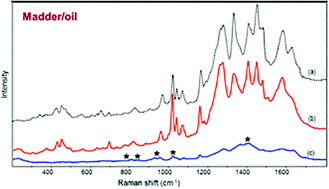
Anal. Methods, 2017,9, 4338-4340
https://doi.org/10.1039/C7AY90097J
dPCR – the digital polymerase chain reaction
The digital polymerase chain reaction provides an important step forwards in the quantitative study of DNA.

Anal. Methods, 2017,9, 4225-4227
https://doi.org/10.1039/C7AY90093G
Proficiency testing of sampling
General guidelines for the proficiency testing of sampling are required to handle the special complications involved.

Anal. Methods, 2017,9, 4110-4111
https://doi.org/10.1039/C7AY90092A
X-ray fluorescence (XRF) analysis of porcelain: Background paper
X-ray fluorescence is used for a wide variety of purposes in the examination of heritage objects made from porcelain.

Anal. Methods, 2017,9, 2371-2374
https://doi.org/10.1039/C7AY90044A
Chemical metrology
This technical brief aims to dispel the mythology of metrology, explain important aspects and demonstrate the value of metrology to chemical measurements.
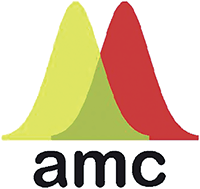
Anal. Methods, 2016,8, 8119-8122
https://doi.org/10.1039/C6AY90155G
UV-visible-NIR reflectance spectrophotometry in cultural heritage: Background paper
Diffuse reflectance spectrophotometry in the ultraviolet, visible and near-infrared spectral range is becoming a widely-used tool for the non-invasive analysis of cultural heritage objects.

Anal. Methods, 2016,8, 5894-5896
https://doi.org/10.1039/C6AY90112C
z-Scores and other scores in chemical proficiency testing—their meanings, and some common misconceptions
ISO 13528 (2015) describes several types of score suitable for interlaboratory studies, but only the simple z-score based on fitness for purpose is recommended here for chemical proficiency tests.
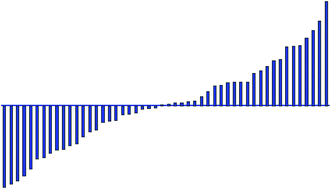
Anal. Methods, 2016,8, 5553-5555
https://doi.org/10.1039/C6AY90078J
Representative sampling? Views from a regulator and a measurement scientist
The term ‘representative sample’ has been redefined many times and become ambiguous. The recommended alternative is ‘appropriate sample’, implying an uncertainty the is fit for purpose.

Anal. Methods, 2016,8, 4783-4784
https://doi.org/10.1039/C6AY90077A
AMC Datasets—a resource for analytical scientists
The datasets provide opportunities for the analyst to try out a variety of statistical procedures for investigating the outcome of chemical measurements.
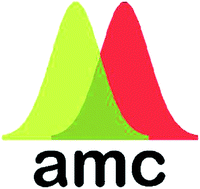
Anal. Methods, 2016,8, 1741-1744
https://doi.org/10.1039/C6AY90016J
Sampling theory and sampling uncertainty
The strengths and limitations of two approaches to the uncertainty derived from sampling (UfS) are compared. Quantitatively, the experimental approach for estimating UfS is more reliable.
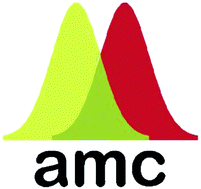
Anal. Methods, 2015,7, 10085-10087
https://doi.org/10.1039/C5AY90098K
An analyst's guide to precision
Precision, quantified as its inverse, is strongly dependent on the conditions of measurement, and is importantly related to uncertainty.
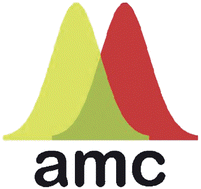
Anal. Methods, 2015,7, 8508-8510
https://doi.org/10.1039/C5AY90071A
Using the Grubbs and Cochran tests to identify outliers
The Grubbs test can be used to identify outliers in the results of replicated measurements. The Cochran test is used to identify groups of results with outlying variance in analysis of variance.

Anal. Methods, 2015,7, 7948-7950
https://doi.org/10.1039/C5AY90053K
Fitness for purpose: the key feature in analytical proficiency testing
Scoring in proficiency testing of analytical laboratories should be based on a fitness-for-purpose criterion.
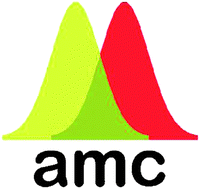
Anal. Methods, 2015,7, 7404-7405
https://doi.org/10.1039/C5AY90052B
Raman spectroscopy in cultural heritage: Background paper
This Technical Brief outlines the advantages and limitations of Raman spectroscopy in cultural heritage research, what the technique can be used for and what type of information can be gathered. The different types of equipment, lasers and experimental set-ups are also discussed.
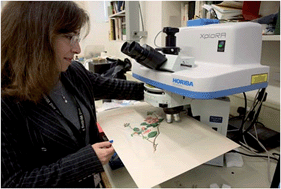
Anal. Methods, 2015,7, 4844-4847
https://doi.org/10.1039/C5AY90036K
Heritage Science – an introduction
Heritage Science is the scientific study of cultural and historic artefacts to assist their conservation and preservation.

Anal. Methods, 2015,7, 2900-2901
https://doi.org/10.1039/C5AY90015H
Sample stability studies for environmental analysis
Ensuring the stability of the test material between sampling and analysis is an essential aspect of chemical measurement.
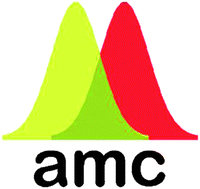
Anal. Methods, 2015,7, 2256-2257
https://doi.org/10.1039/C5AY90008E
Unbalanced robust ANOVA for the estimation of measurement uncertainty at reduced cost
For the estimation of uncertainty from sampling, an unbalanced design combined with a robust analysis of variance provides an economic experiment that is not sensitive to a small proportion of outlying results. Software is provided.

Anal. Methods, 2014,6, 7110-7111
https://doi.org/10.1039/C4AY90062F
Meat and poultry nitrogen factors
The determination of nitrogen as a quantitative marker for meat fat-free protein and the calculation of meat content of compound foods is the established official chemical method to enforce labelling declarations of meat content in food products.
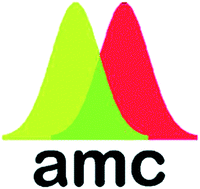
Anal. Methods, 2014,6, 4493-4495
https://doi.org/10.1039/C4AY90043J
Seafood nitrogen factors
The determination of nitrogen as a quantitative marker for fat-free protein is the official chemical enforcement method for the calculation of seafood content of seafood products.
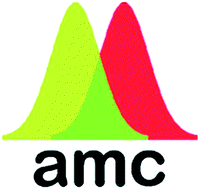
Anal. Methods, 2014,6, 4490-4492
https://doi.org/10.1039/C4AY90042A
The “Phase-of-the-Moon” paradox in uncertainty estimation
Many extraneous factors can affect an analytical result. Analysts preparing an uncertainty budget should use judgement in deciding whether to include uncertainty resulting from empirical tests of implausible influences.
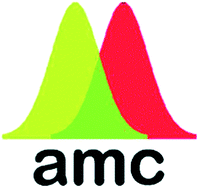
Anal. Methods, 2014,6, 3201-3202
https://doi.org/10.1039/C4AY90024C
Random samples
A representative sample must be unbiased and with an associated between-sample standard deviation that is smaller than that regarded as fit for purpose in the application.
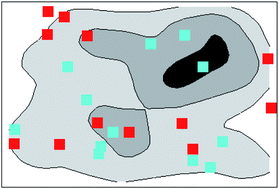
Anal. Methods, 2014,6, 2809-2811
https://doi.org/10.1039/C4AY90023E
PCR – the polymerase chain reaction
The polymerase chain reaction (PCR) has widespread analytical applications in the food, environmental, medical and forensic fields. This Technical Brief covers the basics of PCR and some of its variations.
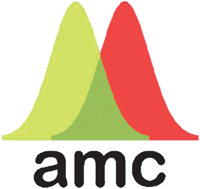
Anal. Methods, 2014,6, 333-336
https://doi.org/10.1039/C3AY90101G
Estimating sampling uncertainty – how many duplicate samples are needed?
Uncertainty from sampling can be estimated by using a hierarchical experiment, but the quality of the uncertainty estimates has to be balanced against the size (and cost) of the experiment.
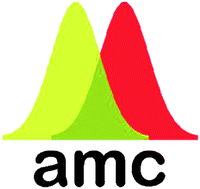
Anal. Methods, 2014,6, 24-26
https://doi.org/10.1039/C3AY90095A
An introduction to non-parametric statistics
Non-parametric statistical methods for significance testing make few assumptions about the distribution of results and are often simple to use.
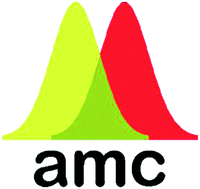
Anal. Methods, 2013,5, 5373-5374
https://doi.org/10.1039/C3AY90070C
What causes most errors in chemical analysis?
Errors in chemical analysis are often discussed but seldom reliably attributed to specific causes. Feedback from participants in proficiency tests is an ideal source of information, however, and a recent study has shown that simple human error is by far the main culprit.
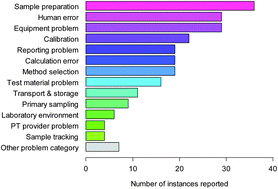
Anal. Methods, 2013,5, 2914-2915
https://doi.org/10.1039/C3AY90035E
Experimental design and optimisation (4): Plackett–Burman designs
Good experimental design is important in many analytical and other chemical studies. The Plackett–Burman method is a popular and economical approach that gives information, in a manageable number of experiments, on the effects of many factors that might influence a chemical measurement.
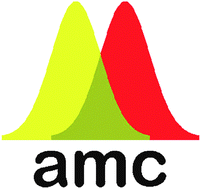
Anal. Methods, 2013,5, 1901-1903
https://doi.org/10.1039/C3AY90020G
Checking the quality of contracted-out analysis
Contracted-out analysis is normally conducted against a specification of the maximum uncertainty acceptable in the results. This Technical Brief outlines some methods by which customers can check whether the specification is being fulfilled.
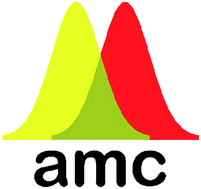
Anal. Methods, 2012,4, 3521-3523
https://doi.org/10.1039/C2AY90044K
Dark uncertainty
Analysts following the GUM method for expressing the uncertainty of their results have a strong tendency to underestimate. This stems from the difficulty of expressing as a measurement model procedures as complex as chemical measurement. The discrepancy is referred to as ‘dark uncertainty’.
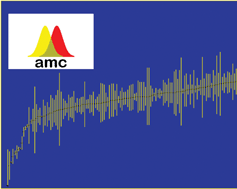
Anal. Methods, 2012,4, 2609-2612
https://doi.org/10.1039/C2AY90034C
Bayesian statistics in action
This Technical Brief outlines some examples of the importance of Bayesian statistical methods in a variety of areas of applied analytical science.

Anal. Methods, 2012,4, 2213-2214
https://doi.org/10.1039/C2AY90023H
Quality control of routine sampling in chemical analysis
Samples from one target differ in composition from the target and from each other. Randomised duplication provides a basis for quality control of sampling and indicates when sampling uncertainty exceeds expectations.

Anal. Methods, 2012,4, 1482-1483
https://doi.org/10.1039/C2AY90022J
Robust regression: An introduction
The latest Technical Brief from the Analytical Methods Committee examines applications of regression methods for calibration and comparison.
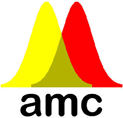
Anal. Methods, 2012,4, 893-894
https://doi.org/10.1039/C2AY90005J
About this collection
The Analytical Methods Committee (AMC) is the Committee of the Royal society of Chemistry Analytical Division that handles matters of technical importance to the Analytical Science Community. The broad aim of the AMC is to participate in national and international efforts to establish a comprehensive framework for appropriate quality in chemical measurement, and to keep the analytical science community informed of developments.
The AMC produce Technical Briefs carefully drafted by expert working groups and peer reviewed by the AMC to provide reliable and up-to-date information on a wide range of analytical topics.
The AMC Technical Briefs have been collated in this online collection and new Technical Briefs will be added as they are published.
When citing these articles please cite the number of the AMCTB e.g. Analytical Methods Committee AMCTB No. 82 as the “authors” of the article.
For more information about the AMC and to access Technical Briefs published before 2012 please visit their website